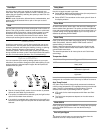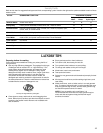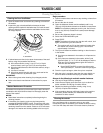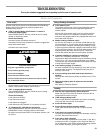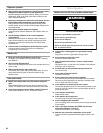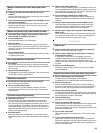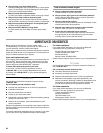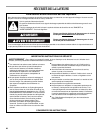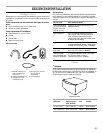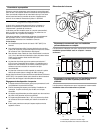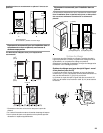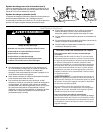
23
Washer continues to fill or drain, drain cycle seems
stuck
■ Is the top of drain hose lower than 30" (76 cm) on
washer?
The top of the drain hose must be at least 30" (76 cm) above
the floor. See “Drain System.”
■ Does the drain hose fit too tightly in the standpipe, or is it
taped to the standpipe?
The drain hose should be loose yet fit securely. Do not seal
the drain hose with tape. The hose needs an air gap. See
“Secure the Drain Hose.”
Washer won’t drain or spin, water remains in washer
■ Is the drain hose clogged, or the end of the drain hose
more than 96" (2.4 m) above the floor?
■ Is your voltage low?
Check electrical source or call electrician.
■ Excessive suds?
When excessive suds are detected, a special suds routine
automatically starts. Cycle will complete once extra suds are
removed. This will occur more frequently when a non-HE
detergent is used.
■ Is the load balanced?
A single or bulky item may cause imbalance. Add more items
or redistribute the load.
Not enough water/Not enough suds
■ Low water?
This washer uses very little water to provide good cleaning
results. You will see little or no water splashing in this washer.
This is normal.
■ Are you using HE detergent?
HE detergent is a low sudsing detergent. This is normal and
will not affect cleaning performance.
Wash/Rinse temperature
■ Are the hot and cold water inlet hoses reversed?
See “Connect the Inlet Hoses.”
■ Are you washing many loads?
As your frequency of loads washed increases, the water
temperature may decrease for hot and warm temperatures.
This is normal.
Cycle time changes/Cycle too long
■ Estimated cycle time?
The cycle times vary automatically based on your water
pressure, water temperature, detergent, and clothes load.
The cycle time will be extended if oversudsing occurs or the
load is unbalanced. The SUDs routine removes extra suds
and assures proper rinsing of your garments. The options you
select will also affect the cycle times that are shown in the
Preset Cycle Settings table.
■ Excessive suds?
When excessive suds are detected, a special suds routine
automatically starts. This routine will add time to the original
cycle.
■ Did the load cause imbalance?
When too much imbalance occurs, an imbalance routine will
start to redistribute the load. During the imbalance routine the
time displayed may pause until this activity is complete, then
resume with the remainder of the cycle.
■ Are you washing a single item or bulky load?
Spin time is added if an unbalanced load is detected. The
washer will attempt to redistribute the load with additional
tumbling.
■ Did you wash a large load on the Quick Wash cycle?
The Quick Wash cycle is designed for smaller load sizes
(2-3 items) of lightly soiled garments. If larger loads are
washed in this cycle, wash time will be increased.
■ Did you wash a large load in a gentle or Delicate/Hand
Wash cycle?
When using the Quick Wash or Delicate/Hand Wash cycles,
you should use small loads. This ensures a gentle wash for
your garments without increasing cycle times.
Clothes Care
Load too wet
■ Did you use the right cycle for the load being washed?
Select a cycle with a higher spin speed.
■ Did you wash a single item or bulky items or have you
overloaded the washer?
A single item, bulky items, or overloading may cause
imbalance. Add items or try to evenly distribute your wet
laundry in the drum, and start a Drain/Spin cycle. If the
laundry is still wet, take half of the load out of the washer and
try again.
■ Did you use HE detergent?
Suds during rinse and spin cycles can reduce spin speed.
Use HE detergent.
Residue, lint, stains on load; gray whites, dingy colors
■ Did you add detergent to the dispenser?
For best results, add detergent to the detergent
compartment. Do not add detergent to the washer drum.
■ Did you sort properly?
Sort lint givers (towels, chenille) from lint takers (corduroy,
synthetics). Dye transfer can occur when mixing whites and
colors in a load. Sort dark clothes from whites and lights.
■ Did you overload the washer?
Do not overload the washer. The washer can be fully loaded,
but not tightly packed. The wash load must be balanced. Lint
can be trapped in the load if overloaded.
■ Check the following:
Was paper or tissue left in pockets?
■ Did you use enough HE detergent?
Follow manufacturer’s recommendations for the type of load
you are washing. For best performance, use only High
Efficiency detergent.
Use enough HE detergent to remove soil
and hold it in suspension.
■ Do you have hard water?
Use more detergent for washing heavy soils in cold or hard
water.
■ Is your water colder than 60°F (15.6°C)?
Wash water colder than 60°F (15.6°C) may not completely
dissolve the detergent. Use hot or warm washes if safe for the
fabric load. Make sure your hot water system is adequate to
provide a hot water wash.




